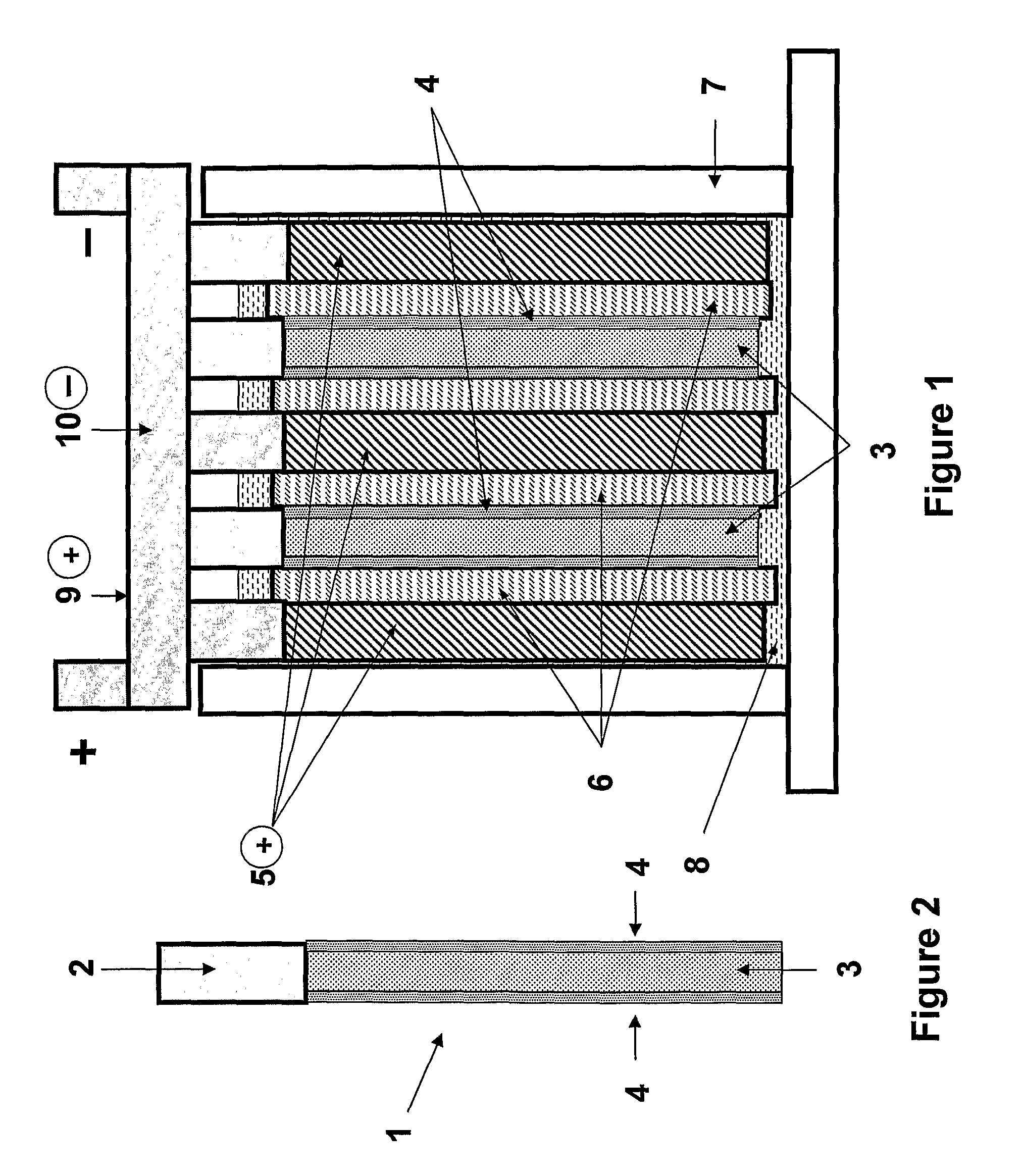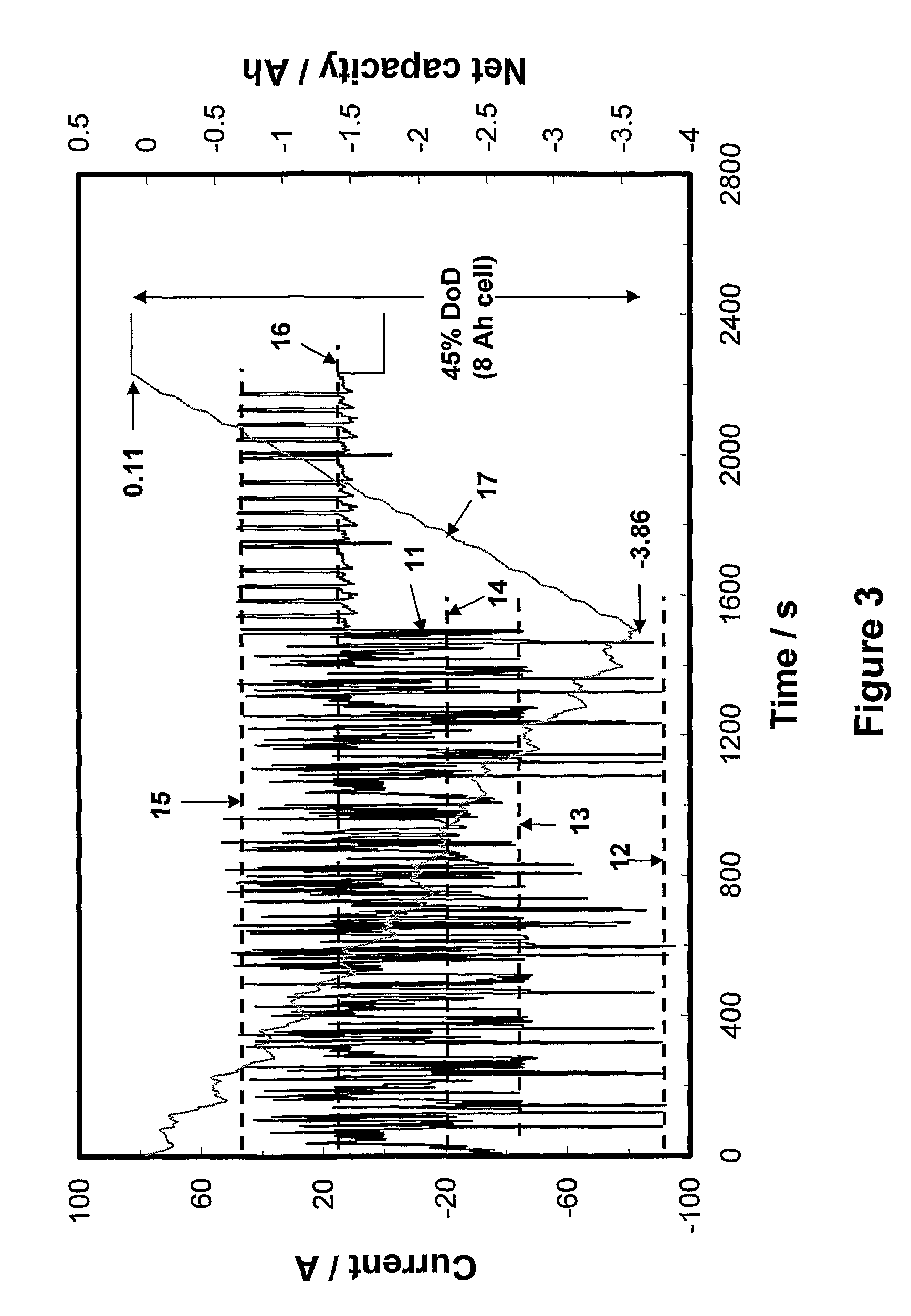Energy storage device
a technology of energy storage and energy storage, which is applied in the direction of cell components, final product manufacturing, sustainable manufacturing/processing, etc., can solve the problems of battery failure, inability to efficiently convert sulphate back, and tendency of negative plate failure of the battery, so as to reduce the concentration of sulfuric acid solution, increase the electrode conductivity, and minimize the effect of heating
- Summary
- Abstract
- Description
- Claims
- Application Information
AI Technical Summary
Benefits of technology
Problems solved by technology
Method used
Image
Examples
reference example 1
[0179]A lead-acid based energy storage device suitable for testing purposes was made in the arrangement as illustrated schematically in FIGS. 1 and 2.
[0180]The device includes two composite negative electrodes (1), which include a current collector (2) with battery negative material (3) pasted thereon, and with a coating of capacitor electrode material (4) on each face of either cured or formed negative material, forming the composite negative electrodes. The device also includes lead dioxide positive electrodes (5) which may or may not contain an additive material, depending on the experiment. The positive and negative electrodes were positioned in an alternating arrangement as illustrated in FIG. 1 in a battery case (7). The positive lead dioxide electrodes (5) can be 20-500 millimetres wide by 20-1200 millimetres high by 0.6-5 millimetres thick. The composite negative electrodes (1, comprising 3 and 4) were of the same range of width and height dimensions with that of the positiv...
reference example 2
[0200]Three cells were used for this example and were made from positive and negative plates with the same width and height dimension, namely, 102 and 107 millimetres, respectively. The thickness of positive plates in each cell was similar, namely, 1.45 millimetres, but that of the negative plate was different. Each cell composed of four positives and five negatives. Two cells were control cells (no additive in positive material and no capacitor material coating on negative plates) and had the negative-plate thickness of 1.35 millimetres. One cell was “high-performance cell” (no additive in positive material, but with capacitor material coated on both faces of the negative plates) and had the negative-plate thickness of 1.6 millimetres. Each cell had a 2-h capacity of 25 Ah. The profile used to evaluate these cells are shown in FIG. 6. This profile is used to simulate the urban driving conditions of HEV and composes of one discharge-current step and three charge-current steps. The a...
example 3
[0201]The discharge and charge processes of a positive plate and the dissolution of lead sulfate at different concentration of sulfuric acid solution are shown below and are represented in FIG. 9.
During discharge, the conversion of lead dioxide to lead sulfate proceeds via two steps. First, the lead dioxide at the positive plate reacts with HSO4− and H+ to form Pb2+, SO42− and H2O, i.e., the so-called ‘dissolution process’ (reaction 1). Then, the Pb2+ combines with SO42− to form PbSO4, i.e., the so-called ‘deposition process’ or ‘precipitation process’ (reaction 2). The first step is an electrochemical reaction and thus involves electron movement and transfer. The electrons pass from the counter negative plate into the positive plate and move to the reactive sites (i.e., lead dioxide) where the electron transfer takes place. The movement of electrons in the positive material occurs through the conductive pathways. This requires more conductive pathways in the positive material matri...
PUM
| Property | Measurement | Unit |
|---|---|---|
| density | aaaaa | aaaaa |
| thickness | aaaaa | aaaaa |
| thickness | aaaaa | aaaaa |
Abstract
Description
Claims
Application Information
 Login to View More
Login to View More - R&D
- Intellectual Property
- Life Sciences
- Materials
- Tech Scout
- Unparalleled Data Quality
- Higher Quality Content
- 60% Fewer Hallucinations
Browse by: Latest US Patents, China's latest patents, Technical Efficacy Thesaurus, Application Domain, Technology Topic, Popular Technical Reports.
© 2025 PatSnap. All rights reserved.Legal|Privacy policy|Modern Slavery Act Transparency Statement|Sitemap|About US| Contact US: help@patsnap.com



